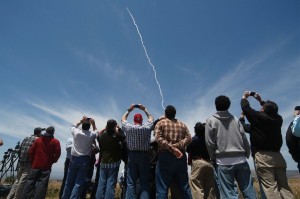The US military said Tuesday it had intercepted a mock-up of an intercontinental ballistic missile in a first-of-its-kind test that comes amid concerns over North Korea’s weapons program.
A ground-based interceptor launched from Vandenberg Air Force Base in California “successfully intercepted an intercontinental ballistic missile target” fired from the Reagan Test Site in the Marshall Islands, the military said in a statement.
The test saw a rocket from the Ground-based Midcourse Defense (GMD) system blast into space and then deploy its “exo-atmospheric kill vehicle,” which smashed into the dummy ICBM, destroying it in a direct collision.
“This system is vitally important to the defense of our homeland, and this test demonstrates that we have a capable, credible deterrent against a very real threat,” Vice Admiral Jim Syring, director of the US Missile Defense Agency, was quoted as saying.
The exercise marked a significant step for the GMD system, which has had a checkered record in previous tests.
Though it succeeded in the last test in 2014, it failed during the three prior attempts against slower-moving, non-ICBM missiles.
“The intercept of a complex, threat-representative ICBM target is an incredible accomplishment for the GMD system and a critical milestone for this program,” Syring said.
Milestone
The success of Tuesday’s test is a watershed moment for the US military’s effort to establish an effective — though limited — ground-based defense against ICBMs.
It came a day after North Korea test-fired yet another ballistic missile, the latest in a series of launches that have ratcheted up tensions over Pyongyang’s quest to develop weapons capable of hitting the United States.
Pentagon spokesman Navy Captain Jeff Davis said Tuesday’s trial was not timed specifically in response to tensions with Pyongyang but that “in a broad sense, North Korea is one of the reasons why we have this capability.”
“They continue to conduct test launches, as we saw this weekend, while also using dangerous rhetoric that suggests they would strike the United States homeland,” Davis said.
He also pointed to Iran’s increasing missile capabilities as threatening US strategic interests in the Middle East.
The technology behind the GMD is extremely complex, and the system uses globally deployed sensors to detect and track ballistic missile threats.
The interception is a move that the Pentagon says is akin to hitting a bullet with another bullet — though at far higher speeds.
“Initial indications are that the test met its primary objective, but program officials will continue to evaluate system performance based upon telemetry and other data obtained during the test,” the US military statement read.
The missile defense system will comprise 44 interceptors by the end of the year, so it could thwart an attack from a rogue state or a volley of rockets.
But the interceptors, based in California and Alaska, would be overwhelmed by a full-scale attack from countries like Russia or China, which could fire dozens of missiles at a time.
Ask me anything
Explore related questions





